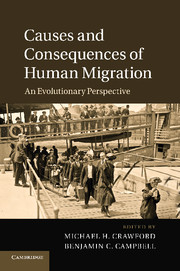Book contents
- Frontmatter
- Contents
- Contributors
- Preface
- 1 Perspectives on human migration: introduction
- Section 1 Theory
- Section 2 Geography and migration
- 8 Population structure and migration in Africa: correlations between archaeological, linguistic, and genetic data
- 9 Human migrations in North Africa
- 10 Identity, voice, community: new African immigrants to Kansas
- 11 The African colonial migration into Mexico: history and biological consequences
- 12 Demic expansion or cultural diffusion: migration and Basque origins
- 13 Consequences of migration among the Roma: immunoglobulin markers as a tool in investigating population relationships
- 14 Migration, assimilation, and admixture: genes of a Scot?
- 15 Mennonite migrations: genetic and demographic consequences
- 16 Human migratory history: through the looking-glass of genetic geography of Mycobacterium tuberculosis
- 17 Peopling the Tibetan plateau: migrants, genes, and genetic adaptations
- 18 Migration, globalization, instability, and Chinese in Peru
- 19 The great blue highway: human migration in the Pacific
- 20 Migration of pre-Hispanic and contemporary human Mexican populations
- 21 A review of the Tupi expansion in the Amazon
- 22 Molecular consequences of migration and urbanization in Peruvian Amazonia
- 23 Migration in Afro-Brazilian rural communities: crossing historical, demographic, and genetic data
- 24 Indentured migration, gene flow, and the formation of the Indo-Costa Rican population
- 25 Causes and consequences of migration to the Caribbean Islands and Central America: an evolutionary success story
- Section 3 Overview
- Index
- References
12 - Demic expansion or cultural diffusion: migration and Basque origins
Published online by Cambridge University Press: 05 December 2012
- Frontmatter
- Contents
- Contributors
- Preface
- 1 Perspectives on human migration: introduction
- Section 1 Theory
- Section 2 Geography and migration
- 8 Population structure and migration in Africa: correlations between archaeological, linguistic, and genetic data
- 9 Human migrations in North Africa
- 10 Identity, voice, community: new African immigrants to Kansas
- 11 The African colonial migration into Mexico: history and biological consequences
- 12 Demic expansion or cultural diffusion: migration and Basque origins
- 13 Consequences of migration among the Roma: immunoglobulin markers as a tool in investigating population relationships
- 14 Migration, assimilation, and admixture: genes of a Scot?
- 15 Mennonite migrations: genetic and demographic consequences
- 16 Human migratory history: through the looking-glass of genetic geography of Mycobacterium tuberculosis
- 17 Peopling the Tibetan plateau: migrants, genes, and genetic adaptations
- 18 Migration, globalization, instability, and Chinese in Peru
- 19 The great blue highway: human migration in the Pacific
- 20 Migration of pre-Hispanic and contemporary human Mexican populations
- 21 A review of the Tupi expansion in the Amazon
- 22 Molecular consequences of migration and urbanization in Peruvian Amazonia
- 23 Migration in Afro-Brazilian rural communities: crossing historical, demographic, and genetic data
- 24 Indentured migration, gene flow, and the formation of the Indo-Costa Rican population
- 25 Causes and consequences of migration to the Caribbean Islands and Central America: an evolutionary success story
- Section 3 Overview
- Index
- References
Summary
Introduction
This chapter examines the possible ramifications of migration (Paleolithic versus Neolithic) on the mitochondrial gene pool of Europe. In the anthropological literature, there has been much debate on the relative contributions of Paleolithic and Neolithic populations to modern Europeans; a debate which continues to center around two competing models (Balaresque et al., 2010; Battaglia et al., 2009; Sjodin and Francois, 2011). The Neolithic demic diffusion model (DDM) holds that the majority of genetic variation found in modern Europeans is the result of bands of migrating farmers spreading their technology (and genes) into Europe with the advent of agriculture (Ammerman and Cavalli-Sforza, 1984). Alternatively, the cultural diffusion model (CDM) asserts that agricultural knowledge spread into Europe 10 000 years ago but people did not, so the transfer of technology occurred without migration and the gene pool of modern Europeans is primarly of non-Neolithic origin (Novelletto, 2007).
Genetic evidence has been used to support both models. A southeast to northwest cline in the distribution of classical markers across Europe has been interpreted as a genetic signature of the DDM model (Cavalli-Sforza et al., 1994). Similar clines have been noted for other molecular systems and interpreted as evidence of “directional population expansion” (Casalotti et al., 1999; Chikhi et al., 1998:9055). Advocates of the cultural diffusion model maintain that the Paleolithic expansion into Europe occurred from the same region as the Neolithic expansion, so that the cline in genetic variation might reflect a Paleolithic signal (Barbujani et al., 1998). Y-chromosome analyses reveal that haplotype R1*M173 appears to indicate an expansion event after the Last Glacial Maximum (Wells et al., 2001), and a “high degree of non-Neolithic ancestry” in populations of Iberia (Flores et al., 2004). Examination of Y-chromosome diversity in southeastern Europe suggests that the spread of agriculture overlaps with the expansion of indigenous European haplogroup I*M423 (Battaglia et al., 2009).
- Type
- Chapter
- Information
- Causes and Consequences of Human MigrationAn Evolutionary Perspective, pp. 224 - 249Publisher: Cambridge University PressPrint publication year: 2012



